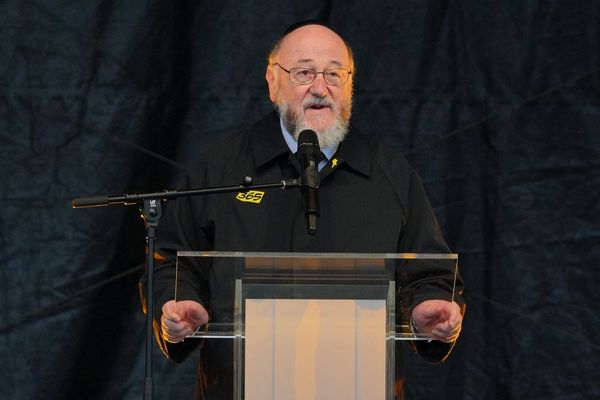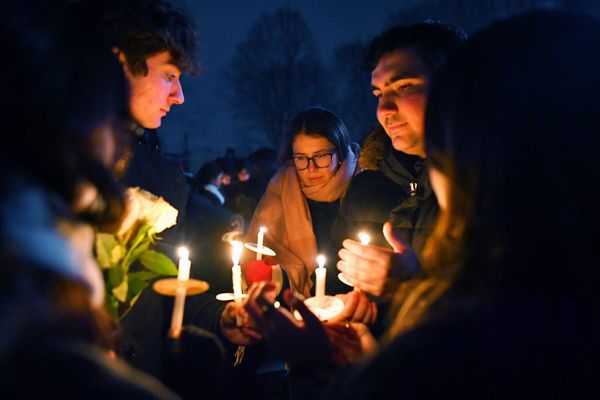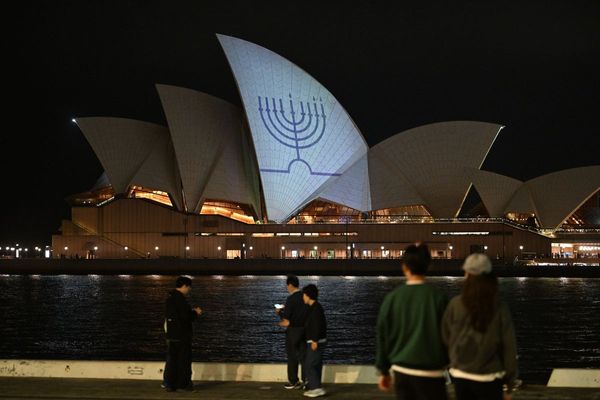DALLAS — Newly released 911 calls obtained by The Dallas Morning News reveal that the man police say broke into the Dallas Museum of Art in June and smashed objects went undetected until he picked up a museum phone and called 911 on himself.
“Hey, I’m in the Dallas Museum of Art,” he told a dispatcher nearly 15 minutes after police say he entered. “Come get me.”
The calls show the museum security force appeared to have no knowledge an intruder was inside the building the night of June 1, even as the man, police say, broke through its glass front door and ambled around three floors. During his rampage, he shattered three Ancient Greek artifacts from the fifth and sixth centuries B.C. and a contemporary Native American artwork, and damaged other property such as display cases, signage and computer equipment, according to police.
The News obtained recordings of the 911 calls and related documents in November after requesting them from police on June 7. Nearly six months later, they provide the clearest picture yet of an extraordinary security failure at Dallas’ art museum, home to works by Picasso, Monet and van Gogh.
Since vowing in June to begin a full audit of its security measures, the DMA, its board and its director, Agustín Arteaga, had been silent about the incident. But in response to the new details being reported exclusively by The News, the museum issued a statement Monday, saying: “As stated in our message to the community in June, we have continued to spend a tremendous amount of time and resources reflecting on and assessing the circumstances surrounding the break-in on June 1. In recognition of the need to take serious action as soon as possible, we committed to hire a third-party consulting firm at that time to review and assess our security measures and facilities. This decision was made to ensure we rely on industry best practices to deter and mitigate similar situations moving forward. We have kept our word and have been working with Chameleon Associates over the last few months to do just that.”
As the only regional art museum with direct ties to a city, it pointed to a need for improvements on two fronts. “The first is continuing to make needed updates to our internal procedures, processes, and standards,” it said.
“The second is working with the City of Dallas to implement critical updates to our facility to deter and prevent such incidents from occurring again. As a City-owned and operated facility,” the museum said, “closer collaboration with and support from the City of Dallas is vital to our success.”
Laying some blame at City Hall, the DMA went on: “As always, we take our responsibility to preserve and protect our visitors, staff, and the art in our care very seriously. We will do everything within our power to prevent similar situations and look forward to critical collaboration with the City of Dallas on deferred maintenance and other operational issues with our facility.”
The DMA’s top spokeswoman, Aschelle Morgan, said the museum has implemented new practices since the break-in but declined to specify them, citing security concerns. “We will also continue to integrate recommendations from our ongoing work with Chameleon Associates,” she said. Headed by Israeli military veterans, the California-based firm provides security consulting and training to a range of groups and venues.
The News reached out to current DMA board members Catherine Marcus Rose, former president of the board of trustees, and Cindy Rachofsky for their reaction to the DMA’s response to the break-in. The News also attempted to contact Howard Rachofsky, Cindy’s husband. The pair is one of three who provided the DMA with the multimillion-dollar Fast Forward bequest. So far, none have responded to inquiries.
A spokesman for Dallas Mayor Eric Johnson, another board member, referred questions to the DMA.
Police arrested and identified the alleged burglar as Brian Hernandez and charged him with criminal mischief of $300,000 or more, a first-degree felony. The 21-year-old is in jail, held on $100,000 bail. He was indicted on Aug. 18 and is awaiting his next court appearance. His public defender did not respond to a request for comment.
The DMA said in a statement the day after the break-in the intruder was unarmed and “Museum security responded immediately.”
But the 911 calls show that Dallas Police dispatch, which spoke to the alleged intruder on the night of the break-in, was the first to alert museum security someone was inside the building about 17 minutes after he entered and, police said, began his destructive spree.
Police records show 911 received a call from the DMA at 9:58 p.m. that a dispatcher labeled a hangup. One minute later, another call came through. It was about 13 minutes after Hernandez stepped inside, according to police. After telling the dispatcher he was inside the museum, the caller, on the recording provided by police, appeared to quickly hang up.
The dispatcher contacted museum security, reaching security officer Jeremiah Roblez at about 10:03 p.m. A LinkedIn page for Roblez lists him as a security shift supervisor at the DMA since 2010.
“We had a call from your facility,” the dispatcher said. “Did someone try to call us?”
“Yeah, we heard the phone start ringing,” Roblez said. “Nothing was going on.”
“Because, it was a male,” the dispatcher said. “I couldn’t really understand what he was saying. I think he said, ‘I’m at the Dallas Museum of Art. Come and get me.’ But I can’t really make out what he’s saying. I’m not sure if it was you guys that were trying to call or if you have someone there, using your phone.”
“It’s just security,” Roblez said. “You couldn’t make out what he was saying? It was a guy?”
“It was a man, yes. He said, ‘I’m at the Dallas Museum of Art,’ and I wanna say he said, ‘Come and get me.’ I might be wrong ‘cause he talked real fast, then he hung up. I’m assuming you guys are closed? Or are y’all still open?”
“Yeah, we’re closed.”
“OK, it’s — I don’t know if someone’s in your building.”
The dispatcher read back the phone number of the call 911 had received, confirming with Roblez it was the museum’s.
“The only other person I know that’s here is security,” Roblez said.
The dispatcher then played a recording of the call to Roblez to see if he recognized the voice. Roblez said he did not.
The dispatcher asked if Roblez wanted police sent to the museum or if he wanted to check on the situation first. Roblez said his group would double-check first, telling her, “I’ve got three officers. They’re all about to split out.”
The conversation lasted about 2 1/2 minutes. The News was unable to reach Roblez for comment.
Police received two more suspicious calls from the museum, records show. The first was labeled a hang-up. Police labeled the incident as a burglary in progress at 10:05 p.m. The second call was a man believed to be the burglar again.
“Hi, I’m in the Dallas Museum of Art,” he said.
“What is the physical address there?” a dispatcher asked.
“I just broke in,” he said.
The dispatcher asked again for the address, and the caller said he didn’t know before appearing to hang up.
What happened next is unclear. Another DMA security guard, identified by police as Luis Gomez, who was with Roblez in the museum, according to police, later told them a motion sensor had gone off, prompting security to check cameras. After seeing cables on the ground in the concourse, Gomez and Roblez headed there and found Hernandez, police noted in an arrest report.
Officers responded about 10:10 p.m. and arrived at the museum at 10:16 p.m., according to records. They found Hernandez sitting on a bench just inside the building, they said, having been apprehended by security. Hernandez was arrested at 10:21 p.m., more than 30 minutes after arriving at the museum’s door.
By the time security was alerted by the dispatcher on the phone, Hernandez had already roamed through three floors of the building, according to police. Basing their account on security footage and a walk-through of the premises, police said Hernandez had approached the building’s Flora Street entrance with a metal chair about 9:40 p.m. By about 9:46 p.m., he was inside, police said, where he “immediately began throwing items on the ground.”
Citing the museum’s policy on personnel matters, Morgan, the spokeswoman, refused to discuss if it has made any changes to its security staff.
The damage over three floors
Hernandez went to the ancient Mediterranean gallery, police said, on the second floor of the encyclopedic DMA, whose collection includes more than 25,000 works of art spanning 5,000 years.
Police said Hernandez punched a glass display case several times. Returning to the museum’s entrance, he grabbed a metal stool, according to police. He then walked back upstairs and hit two more display cases, police said, shattering them and breaking three ancient Greek vessels inside — an amphora, a small box and a drinking bowl.
In the third floor’s decorative arts and design gallery, where police said he appeared next at 9:50 p.m., he used a stanchion to shatter four display cases. At 9:52 p.m. he was back on the first floor, where, police said, he threw to the ground a 4-foot Native American effigy bottle, shattering it. Caddo artist Chase Kahwinhut Earles of Oklahoma told The News that the effigy — a showpiece of the exhibit “Spirit Lodge: Mississippian Art from Spiro” — became a “defining piece for my career” when the DMA acquired it in 2020. Crafted using ancestral techniques, it depicted an alligator gar.
Security expert John Barelli, who spent 38 years at the Metropolitan Museum of Art in New York — his last 30 as chief security officer before he retired in 2016 — reacted with astonishment to what the 911 calls revealed.
“My initial reaction is, the museum is lucky that he didn’t do more damage,” Barelli said. “And in fact, he’s lucky — or rather, they’re lucky — that if their system didn’t work, somebody who really wanted to steal a lot could have done so. They obviously had a security system that was not functioning.”
During the break-in, the museum was housing more than 400 precious objects as part of an exhibit on French fashion house Cartier. They included works from the Louvre.
“They would have been in bad trouble,” Barelli said, had the suspect chosen to do further damage or walk away with priceless works of art. “As it was, he was able to do what he did, but who knows what else he might have done?”
Has he ever heard of such a thing happening at an art museum? No, Barelli said flatly, he has not. Barelli is also the author of the 2019 book "Stealing the Show: A History of Art and Crime in Six Thefts."
“It would be nice to know,” he added, “to what extent the system (in Dallas) didn’t work.”
In recent coverage by The News, Barelli said he would be happy to offer his services to the Dallas Museum of Art. But, he said, he was never contacted.
“This really is an amazing thing,” he said. “I’ve never heard of something like that happening. And they’re awful lucky that it happened the way it happened.”
To have a fail-safe security system, “It takes a lot of time and money. You have to maintain these systems. And if you don’t maintain them, they’re not going to work. It takes a lot of time. And I will guarantee you that about 90% of museum security systems are not functioning at 100%.”
Dallas’ own Robert Edsel, founder and chairman of The Monuments Men and Women Foundation, authored the bestselling book "The Monuments Men," which became a Hollywood movie starring George Clooney, Cate Blanchett and Matt Damon. Its subject matter? Millions of pieces of fine art plundered by the Nazis.
“I’m shocked, and I’m very disappointed,” Edsel said about the latest findings regarding the DMA break-in. “I’m as bothered by the lack of transparency by museum leadership as I am the revelation about the alarm system apparently not functioning at all.”
Edsel said the new information underscores what he called “a stand-up, jump-up-and-down, light-your-hair-on-fire moment. The primary responsibility of a museum director is to protect the museum and its assets. And my personal opinion is that the No. 1 asset of the museum is its reputation.”
In Edsel’s words, the DMA, like many across America, is a “public institution, funded with taxpayer money, in the form of donations and 501(c)(3) tax exemptions,” he said. “Its duty to comply with the rules greatly supersedes the responsibility of yours and mine as private citizens and collectors.”
The DMA received $1,123,896 from the Dallas Office of Arts and Culture during the 2021-22 fiscal year and is receiving the same amount during the current fiscal year. The city also provides services and routine maintenance for the building. During the previous fiscal year that ran from July 1, 2021, to June 30, 2022, the Office of Arts and Culture allocated $886,155 to the museum in compensation for expenses related to its use of utilities and “non-standard maintenance.”
The museum’s total budget nears $29 million.
The last time the DMA received funding through a citywide election came via the 2017 Bond Program, under Proposition F — for cultural and performing arts facilities — when the city allocated $6 million to the DMA.
“We don’t talk much about security matters because it’s been an accepted fact by the public and the boards of these museums that there will be top-dollar security to protect the assets from theft and destruction. The idea that that responsibility has been penetrated or pierced by — I’m not sure what other word to use — incompetence should be as distressing to every citizen whose taxpayer money is helping fund that museum, as it should be to the board of directors,” Edsel said.
———
(Dallas Morning News staff writers Kelli Smith and Maggie Prosser contributed to this report.)
———







